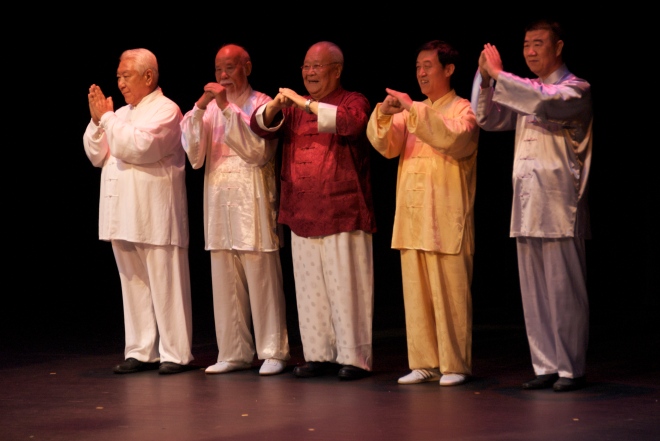
Master Chen Zhenglei, one of the "4 Tigers"
Newsflash!
- Barack Obama studied with Chen Tai Chi Grandmaster Chen Zhenglei in 1998!
- According to the latest studies, Tai Chi practitioners were found to be more relaxed than yoga practitioners after one year of practice. In fact, the yoga practitioners were more stressed than when they started!
- After just 2 weeks of Tai Chi class, people with osteoarthritis reported major improvements, including weight loss and better pain management.
These are some of the more interesting tidbits of information that I picked up at the International Tai Chi Symposium held in Nashville, Tennessee from July 5-11. This historic event brought together the grandmasters of the 5 major families of Tai Chi Chuan (Wu, Wu-Hao, Yang, Chen, and Sun for those who might not be aware of the fine distinctions) for the first time in a spirit of education and cultural exchange with 400 Tai Chi practitioners, teachers, students and academic and medical researchers who are committed to bringing Tai Chi into the 21st century. Given the traditional secrecy associated with the various family styles, sometimes it felt like all of the Mafia dons of New York and New Jersey were having a major pow-wow!

Master Ma Hailong, Master Wu Wenhan, Master Yang Zhenduo, Master Chen Zhenglei, Master Sun Yongtian
3 of these guys were elders (75 to mid-80’s) and the other 2 were middle-aged holders of the family lineage. Having lived and breathed Tai Chi since childhood, watching them do their forms was witnessing the fruits of years and years of practice. They were inspirational examples of the best that Chinese martial arts offer.
We listened to all the grandmasters hold forth in a keynote speech translated for the audience and then attempted to learn a 16 movement routine in each style; watched beautiful demonstrations by them, their students, and other luminaries of the world of internal arts; heard panel discussions on academic and medical research on Tai Chi; listened to new and creative applications of Tai Chi for special populations, and contemplated the future of the art with new and old Tai Chi friends.
It was a very male, China-centric event with many toasts, speeches, endless clapping and self-congratulation at such a historic moment. Women took a secondary role throughout the symposium. Master Helen Wu

Master Helen Wu
and Master Zifang Su Master Zifang Su, the two female masters, gave pre-conference seminars and most participants did not even know they were there until the last demonstration. Two of the daughters helped their fathers teach and to their credit, did an excellent job, particularly Chen Zhenglie’s daughter, a very fine Chen style practitioner. In a poignant footnote to the value of women in Chinese culture, a local Nashville charity – Annabelle’s Wish – made regular pitches for financial donations to help the orphanages in China that are primarily full of unwanted girls due to China’s family planning policy.

Master Zifang Su demonstrating self-defense applications w/ her son
One Grandmaster stated that one must understand Chinese culture in order to understand Tai Chi. A Chinese master currently living in Kansas City rebutted this with a statement that I feel is more true at this stage of Tai Chi’s development. He said the truth was that you couldn’t really understand Tai Chi unless you understand physics. Ah so! I can get behind that one.
It’s important to note that Buddhism developed differently in China than it did in Japan or Tibet. It seems reasonable that Tai Chi will also have its own developmental trajectory and develop a distinctly western (if not American) flavor since it will inevitably be influenced by what’s going on here. This will not be the classicism of the original as represented by these 5 grandmasters, but a meditational movement form that will be influenced by scientific and medical advances, the fitness industry, and all of the so-called New Age movement styles (Feldenkrais, Authentic Movement, etc.). After all, most people here although they are interested in the self-defense applications, practice Tai Chi for their health. It seems logical that Tai Chi as well as other practices from the East (yoga included) will necessarily evolve as the culture does — becoming more nurturing, less hierarchical, and less male-dominated.
©Photographs by Sharon Smith
All rights reserved.
Click here for more pictures of the Grandmasters.

Master Sun Yongtian (the Fighter) w/ his student

Master Yang Zhenduo, the "Dalai Lama" of Tai Chi

Master Wu Wenhan, the Intellectual

Master Ma Hailong, the Aesthete
